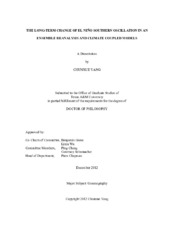| dc.description.abstract | Long-term changes of El Niño/Southern Oscillation (ENSO) are studied with the ensemble run of Simple Ocean Data Assimilation (SODA 2.2.6) and the Coupled Model Intercomparison Project Phase 5 (CMIP5). An eight member ocean reanalyses (SODA 2.2.6) from 1871 to 2008 is produced by using forcing from eight ensemble members of an atmospheric reanalysis. The ensemble reanalysis shows that El Niño has prominent decadal variability. Weak El Niños occur throughout the entire record whereas the occurrence of strong El Niños varies, with strong El Niño at the beginning and end of the record. The strength of La Niña is weaker than for El Niño, and has less variability. Although for any given El Niño year all ensemble members show the occurrence of El Niño, in some ensemble members the El Niño is strong while in others it is weak. When the timing of the onset of Westerly Wind Bursts (WWBs) occurs earlier in the year and the strength of WWBs is stronger, strong El Niño occurs.
To study the importance of the background state in the tropical Pacific Ocean on ENSO, long-term trends of tropical Pacific SST, wind stress, subsurface temperature and the sub-tropical cells (STCs) are analyzed. The reanalysis shows that there is a slight cooling trend of SST in the central tropical Pacific due to an enhanced tropical Pacific circulation. Subsurface temperature also has a cooling trend. The STCs, which consist of equatorial upwelling, Ekman transport, extra-tropical subduction and pycnocline transport from the sub-tropical to the tropical region, strengthen from 1900 to 2008. When the STCs are accelerated, equatorial upwelling increases bringing cold water from the subsurface that cools the surface.
ENSO variability is also analyzed in the CMIP5 historical experiments. Results show that most of the models have a realistic representation of the strength of ENSO; however, the location of warming generally extends too far to the west. Overall, properties of ENSO do not show a significant change in most of the CMIP5 models. One distinguishing difference between the CMIP5 models and SODA 2.2.6 is that ENSO in SODA 2.2.6 has prominent asymmetry between El Niño and La Niña, whereas ENSO in the CMIP5 models tends to have fairly symmetric El Niño and La Niña. In contrast with the reanalysis most of the CMIP5 models have warming trends at the surface and the transport of the STCs has a decreasing trend. | en |


